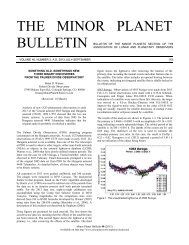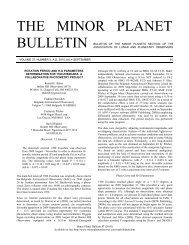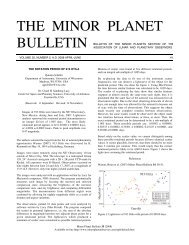THE MINOR PLANET BULLETIN - MinorPlanet.Info
THE MINOR PLANET BULLETIN - MinorPlanet.Info
THE MINOR PLANET BULLETIN - MinorPlanet.Info
- No tags were found...
You also want an ePaper? Increase the reach of your titles
YUMPU automatically turns print PDFs into web optimized ePapers that Google loves.
101<br />
angles and those on alternate nights nearly the same phase in the<br />
lightcurve, with a slow circulation toward the right (increasing<br />
phase). New all-night observations of both sides of the lightcurve<br />
were obtained every 4 to 8 days to achieve complete coverage<br />
with abundant overlap. The most prominent feature is a single<br />
deep minimum near phase 0.23. As the rotational phase presented<br />
during the observable part of the night slowly circulated, three sets<br />
of observations of this feature were obtained that served to anchor<br />
the period determination; however the 46.551 hour period also fits<br />
the shallow features well. The possibility that the period might be<br />
twice as long was investigated and can be ruled out entirely. On a<br />
lightcurve phased to 93.11 h, the two halves looked very similar to<br />
each other and to the lightcurve phased to 46.551 h. A shape<br />
sufficiently irregular to produce this lightcurve yet invariant over a<br />
180-degree rotation is unlikely for real asteroids. An<br />
approximately 93-hour period is compatible with the 0.22 mag<br />
amplitude lightcurve obtained by Bembrick and Allen (2005) only<br />
if there are four maxima and minima per cycle. While such a curve<br />
is possible, even with amplitudes of about 0.2 mag, they are rare<br />
and require extraordinary evidence. Such evidence is lacking in<br />
this case.<br />
131 Vala. Pilcher (2008) published a symmetric bimodal<br />
lightcurve phased to 10.359 h based on observations obtained<br />
2007 October and November that showed an amplitude 0.09 ±<br />
0.02 mag. However, the result was not considered secure since the<br />
high degree of symmetry and small amplitude suggested a pole-on<br />
viewing aspect with a period near 5.18 h and monomodal<br />
lightcurve. Investigation at the following opposition was<br />
recommended to resolve the ambiguity. The first night of<br />
observation, 2009 Feb. 7, confirmed the pole-on hypothesis,<br />
showing a bimodal lightcurve bimodal with P = 5.18 h.<br />
Lightcurves for the 2007 and 2009 observations are presented here<br />
with the 2007 data phased to a period of 5.179 ± 0.001 h. The new<br />
observations on five nights 2009 Feb. 7 – Mar. 14 show a period<br />
5.1812 ± 0.0001 h, amplitude 0.28 ± 0.03 mag.<br />
271 Penthesilea. Harris et al. (2008) list no previous photometric<br />
measurements. Observations on seven nights 2009 Jan. 1 – Feb.<br />
17 show a period of 18.787 ± 0.001 h, amplitude 0.32 ± 0.04 mag.<br />
Acknowledgements<br />
The author thanks Alan W. Harris for helpful suggestions on the<br />
data analysis for 157 Dejanira.<br />
References<br />
Bembrick, C. S., and Allen, B., (2005) “120 Lachesis – A Very<br />
Slow Rotator.” Minor Planet Bul. 32, 45-46.<br />
Harris, A. W., Warner, B. D., and Pravec, P., “Asteroid Lightcurve<br />
Data File, Revised Mar. 10, 2008.”<br />
http://www.<strong>MinorPlanet</strong>Observer.com/astlc/default.htm.<br />
Pilcher, F. (2008) “Period Determinations for 84 Klio, 98 Ianthe,<br />
102 Miriam, 112 Iphigenia, 131 Vala, and 650 Amalasuntha.”<br />
Minor Planet Bul. 35, 71-72.<br />
Warner, B. D., (2005) “Asteroid Lightcurve Analysis at the<br />
Palmer Divide Observatory – Spring 2005.” Minor Planet Bul. 32,<br />
90-92.<br />
If one obtains a nearly symmetric bimodal lightcurve of small<br />
amplitude, for which the two halves look almost the same, there is<br />
a good possibility that the target asteroid is in near-polar aspect<br />
with a rotation period half that of the bimodal lightcurve. If<br />
possible the object should be observed at a future opposition at<br />
which the phase angle bisector longitude is at near right angles to<br />
the original observations. If the two lightcurves show significantly<br />
different amplitudes, then the viewing aspect for the apparition<br />
with the lower amplitude was very probably pole-on.<br />
157 Dejanira. Warner (2005) obtained lightcurves on six nights<br />
2005 Apr. 22-May 13 and found a period of 15.819 h, amplitude<br />
0.52 mag. One set of new observations was obtained on five<br />
nights, 2008 Dec. 21 – 2009 Jan. 8, at phase angles 24.4° to 19.7°<br />
with full phase coverage and showed a synodic period 15.817 ±<br />
0.001 h, amplitude 0.48 ± 0.02 mag., in excellent agreement with<br />
Warner (2005). A second set of observations on three nights 2009<br />
Feb. 11–23 at phase angles 9.9° to 11.4°, also with full phase<br />
coverage, showed a synodic period 15.828 ± 0.001 h, amplitude<br />
0.38 ± 0.02 mag. This smaller amplitude at smaller phase angle is<br />
usually encountered for asteroids because of less shadowing. A<br />
synodic period increase on the later dates when the prograde rate<br />
of motion of the phase angle bisector is much smaller than in<br />
December/January implies retrograde rotation. Because real errors<br />
in rotation periods are often several times larger than formal<br />
errors, this suggestion should be considered provisional. The<br />
observations on all eight nights evaluated as a single set produce a<br />
mean synodic period of 15.825 ± 0.001 h.<br />
Minor Planet Bulletin 36 (2009)










